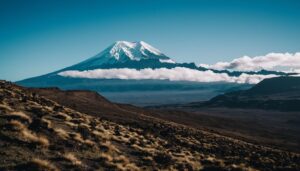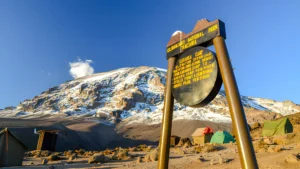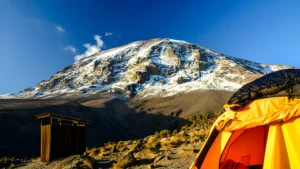Conquering the Roof of Africa
The Ultimate Guide to Climbing Kilimanjaro in Tanzania
Ultimate Kilimanjaro Climbing Guide Tanzania
At 5,895 meters (19,340 feet) above sea level, Kilimanjaro rises. It is known as the ‘Roof of Africa’ and is the tallest free-standing peak in the entire world. One of the most visited tourist destinations on the continent is Mount Kilimanjaro. Every year, more than 40,000 people go there. Its appeal is due to a few straightforward factors. Climbers don’t need technical climbing abilities to complete this breathtaking excursion.
All one needs is a healthy average level of fitness to reach the top. For this reason, many people start their Seven Summits expedition from Mount Kilimanjaro. To help climbers be ready for their once-in-a-lifetime experience on Kilimanjaro, we developed this handbook. The suggestions listed below are all the outcomes of our extensive seven-year Kilimanjaro experience.
Climbing Kilimanjaro routes and their difficulty levels
Facts to know before your Kilimanjaro hike
Climbing Kilimanjaro, Africa’s tallest peak, requires thorough preparation and knowledge. First, the trek typically takes 5-9 days, depending on the chosen route, with the Marangu, Machame, and Lemosho routes being the most popular. Acclimatization is crucial due to the risk of altitude sickness, as the summit stands at 5,895 meters (19,341 feet). Training beforehand, focusing on cardiovascular fitness, leg strength, and endurance, is recommended. Pack appropriately for varying weather conditions, from tropical at the base to freezing temperatures near the summit. Hiring a reputable guide service is mandatory, as independent trekking is not allowed. Lastly, be prepared for early starts, slow ascents, and the incredible reward of standing on Africa’s highest point.
Height: 19,340 ft/5,895 m
Type: Dormant volcano
The closest airport: is Kilimanjaro International Airport
Peaks: Kibo, Mawenzi, Shira
Climate zones: Cultivated, Rainforest, Moorland, Alpine, Arctic
Last major eruption: 360,000 years ago
Mountaineering skills: Not required; Average fitness level
First ascent: 1889, Hans Meyer and Ludwig Purtscheller
Popular questions about Climbing Kilimanjaro
Mount Kilimanjaro, the highest mountain in Africa, is located in northeastern Tanzania near the border with Kenya. This majestic peak, which rises approximately 5,895 meters (19,341 feet) above sea level, is part of the Kilimanjaro National Park. Situated just 330 kilometers (205 miles) south of the equator, Kilimanjaro is a prominent landmark in the region, comprising three volcanic cones: Kibo, Mawenzi, and Shira. The mountain’s diverse ecosystems range from lush rainforests at its base to barren alpine deserts at higher elevations, culminating in the snow-capped summit of Uhuru Peak.
The best time to climb Mount Kilimanjaro is during the dry seasons, which typically occur from late June to October and from late December to early March. These periods offer the most stable weather conditions, with less rainfall and clearer skies, which enhance the overall climbing experience. The drier trails are less slippery, reducing the risk of accidents, and the visibility is generally better, allowing for breathtaking views of the surrounding landscapes. While these months attract more climbers, resulting in busier trails, the improved conditions significantly increase the likelihood of a successful and enjoyable ascent to the summit.
Mount Kilimanjaro, located in Tanzania, is the highest peak in Africa, standing at approximately 5,895 meters (19,341 feet) above sea level. This majestic mountain is a free-standing volcanic structure, comprised of three distinct cones: Kibo, Mawenzi, and Shira. Kibo is the tallest of these cones and features the mountain’s highest point, Uhuru Peak. Kilimanjaro’s impressive height and prominent isolation make it one of the most iconic and sought-after summits for climbers and adventurers worldwide. Its diverse ecological zones, ranging from tropical rainforests at its base to arctic conditions at its summit, add to the mountain’s allure and challenge.
Climbing Mount Kilimanjaro typically takes between five to nine days, depending on the route chosen and the climber’s pace. The shorter routes, like the Marangu and Rongai routes, usually take five to six days to complete. In contrast, longer routes such as the Lemosho, Machame, and Northern Circuit routes can extend to eight or nine days, allowing for better acclimatization and a higher success rate of reaching the summit. The duration of the climb is influenced by factors such as altitude acclimatization, weather conditions, and the physical fitness of the climber. Taking more days not only increases the chances of a successful ascent but also provides a safer and more enjoyable experience by reducing the risk of altitude sickness.
The cost of climbing Mount Kilimanjaro varies widely depending on several factors, including the route chosen, the length of the trek, the level of service and support, and the time of year. On average, a budget climb can cost between $1,500 to $2,500, while mid-range packages typically range from $2,500 to $4,000. For a more luxurious experience, with added comforts and services, prices can go upwards of $5,000 to $7,000 or more. These costs generally cover park fees, camping fees, guide and porter services, food, and transportation to and from the mountain. Additional expenses may include tips for the crew, travel insurance, gear rental, and personal expenses, making the total cost of the adventure potentially higher.
Climbing Mount Kilimanjaro without a guide is not permitted by Tanzanian regulations. The government mandates that all climbers must be accompanied by a registered guide to ensure safety and to help preserve the mountain’s environment. This policy not only promotes the welfare of climbers by providing expert knowledge and assistance but also supports local economies through employment opportunities for guides and porters. While the challenge of scaling Africa’s highest peak might tempt some adventurers to go solo, adhering to this regulation is essential for a successful and responsible ascent.
The park fees for climbing Mount Kilimanjaro can be quite substantial, reflecting its status as a premier trekking destination. As of 2024, the total cost for park fees, which include the conservation fee, camping or hut fees, and rescue fees, ranges from approximately $800 to $1,100 per person for a typical seven-day trek. These fees are necessary to maintain the park’s infrastructure, support conservation efforts, and ensure the safety of climbers. Additional costs such as guide and porter fees, equipment rentals, and tips further add to the overall expense, making a Kilimanjaro expedition a significant financial commitment for adventurers.
Looking for a private climbing Kilimanjaro for your dates?
Preparing and training for Climbing Kilimanjaro Tanzania
Training for a Mount Kilimanjaro climb requires a comprehensive fitness regimen focused on building endurance, strength, and acclimatization to altitude. Begin by incorporating cardiovascular exercises such as running, cycling, or swimming to boost stamina, aiming for at least 30 minutes of moderate to intense activity, five days a week. Complement this with strength training, particularly for the legs, core, and upper body, through exercises like squats, lunges, planks, and push-ups.
Hiking on varied terrains, especially at increasing altitudes, is crucial for simulating the climb and enhancing your body’s adaptation to lower oxygen levels. Additionally, practice using your hiking gear, such as boots and backpacks, to ensure comfort and reduce the risk of blisters or injuries.
Remember to maintain a balanced diet and stay hydrated to support your training efforts. Lastly, consult with a healthcare provider to discuss altitude sickness prevention and ensure you are physically prepared for the demands of the climb.
As an athlete preparing to climb Mount Kilimanjaro, it’s essential to recognize the unique physical and mental demands of such an endeavor. While your athleticism may provide a solid foundation, altitude sickness and extreme weather conditions can pose significant challenges. Prioritize altitude acclimatization by allowing ample time for your ascent, staying well-hydrated, and listening to your body’s signals.
Incorporate strength and endurance training into your preparation regimen to ensure you have the stamina for the long trek. Additionally, mental fortitude and determination will be invaluable as you navigate the varying terrain and altitude levels.
Remember to pack essential gear, including layers for temperature fluctuations, sturdy footwear, and high-energy snacks to fuel your journey. Lastly, approach the climb with respect for the mountain and its environment, embracing the awe-inspiring experience while staying mindful of safety precautions.
Tanzania has two rainy seasons and two dry seasons. The short rainy season begins in early November and lasts until late December. It is followed by the dry season, which lasts until mid-March. Then the season of long rains begins, ending in mid-June.
You should consider the northern slopes to climb Kilimanjaro during the rainy season. According to the data we received from the Tanzania Meteorological Authority, this part of the mountain receives five times less rainfall. Good Kilimanjaro routes to choose from are Rongai, Northern Circuit, and Marangu.
One should also remember that the period from June to October in East Africa is marked by cold nights. At the high altitudes of Kilimanjaro, the nights will be pretty chilly. Make sure you have everything from our packing list.
Food on a Kilimanjaro climb is a blend of sustenance and adventure, vital for fueling trekkers on their journey to Africa’s highest peak. Most tour operators provide hearty meals designed to replenish energy and satisfy appetites amidst the challenging terrain.
Expect a diverse menu featuring a mix of local Tanzanian dishes and international favorites, carefully prepared by experienced cooks. Typical fare includes:
- Hearty Soups: To warm you up and provide hydration.
- Carbohydrates: Staples like pasta and rice to replenish energy.
- Protein: Rich options such as meats or legumes for muscle recovery.
- Fresh Fruits and Vegetables: For essential vitamins and minerals.
- Snacks: Nuts and energy bars for quick boosts during the trek.
Despite the altitude and rugged conditions, these meals aim to offer comfort and nourishment, becoming a memorable part of the Kilimanjaro experience.
At Jairos Adventure, we have conducted an in-depth analysis and examined the data from January 1, 2023, to September 30, 2023. We looked at the records of over 40,000 climbers.
Our findings revealed that starting your trek on a Wednesday or Thursday reduces the crowds you will encounter. There are almost twice fewer climbers starting on these days compared to the rest of the week.
Additionally, we discovered that the Rongai route has eight times fewer climbers than the popular Machame route. Thus, by hiking Mount Kilimanjaro on Thursday and opting for the Rongai route, you’ll encounter nearly 16 times fewer climbers on your way to Uhuru Peak.
The best day to embark on a Mount Kilimanjaro trek often depends on various factors, including weather conditions, personal preferences, and tour availability. Generally, the dry season, which spans from late June to October, is considered ideal for climbing due to clearer skies and lower precipitation, enhancing visibility and minimizing the risk of encountering slippery trails. Additionally, weekdays may offer slightly fewer crowds compared to weekends, providing a more serene experience on the mountain. However, individual schedules and logistical considerations play a significant role in determining the optimal starting day for each trekker, ensuring a safe and enjoyable journey to the summit of Africa’s tallest peak.
Climbing Mount Kilimanjaro without a guide is not permitted by Tanzanian regulations. The government mandates that all climbers must be accompanied by a registered guide to ensure safety and to help preserve the mountain’s environment. This policy not only promotes the welfare of climbers by providing expert knowledge and assistance but also supports local economies through employment opportunities for guides and porters. While the challenge of scaling Africa’s highest peak might tempt some adventurers to go solo, adhering to this regulation is essential for a successful and responsible ascent.
The park fees for climbing Mount Kilimanjaro can be quite substantial, reflecting its status as a premier trekking destination. As of 2024, the total cost for park fees, which include the conservation fee, camping or hut fees, and rescue fees, ranges from approximately $800 to $1,100 per person for a typical seven-day trek. These fees are necessary to maintain the park’s infrastructure, support conservation efforts, and ensure the safety of climbers. Additional costs such as guide and porter fees, equipment rentals, and tips further add to the overall expense, making a Kilimanjaro expedition a significant financial commitment for adventurers.
What should I pack for a successful summit Kilimanjaro?
Tents, comfortable beds, tables, silverware, chairs, and other items are available at Jairos Adventure. But you have to pack your trekking equipment. Along with other goods from the packing list, this includes boots, a sleeping bag, duffel bags, jeans, and trekking poles.
Climbing Mount Kilimanjaro causes significant temperature variations. Temperatures range from -15°C/5°F to 25°C/77°F. It is important to pack for any type of alpine weather.
You may rent gear from Jairos Adventure shop if you want to travel light or don’t want to buy it. We have a large selection of top-notch, well-maintained equipment in stock.
Packing for a successful summit requires careful consideration of essential gear and provisions. Begin with appropriate clothing layers to combat changing weather conditions, including moisture-wicking base layers, insulating mid-layers, and a waterproof outer shell. Don’t forget sturdy hiking boots with good ankle support and traction for varied terrain.
Pack enough food and water to sustain you throughout the climb, opting for lightweight, high-energy snacks and a hydration system to stay properly fueled and hydrated. Essential gear such as a headlamp, first aid kit, navigation tools, and a multi-tool should be included for safety and preparedness.
Additionally, carry adequate sun protection like sunscreen, sunglasses, and a wide-brimmed hat, as well as emergency essentials like a space blanket and fire starter. Lastly, ensure your backpack is properly fitted and comfortable for long hours on the trail. With careful planning and the right gear, you’ll be well-prepared for a successful summit adventure.
Check our Kilimanjaro Packing List to learn everything you need to know. Download here.
Training and physical preparation for climbing Kilimanjaro
Training and physical preparation for climbing Kilimanjaro are crucial to ensure a successful and enjoyable ascent. Start with a solid cardiovascular fitness regimen that includes running, cycling, or swimming to build endurance. Complement this with strength training exercises such as squats, lunges, and planks to strengthen your legs, core, and upper body.
Regular hiking on varied terrains is essential, gradually increasing the difficulty and altitude to simulate mountain conditions. Incorporate flexibility and balance exercises like yoga to enhance overall agility and prevent injuries.
Consistency in training will prepare your body to handle the rigors of the climb, making the journey up Kilimanjaro more manageable and rewarding.
Safety measures and precautions on Climbing Kilimanjaro
Safety on Mount Kilimanjaro is paramount to a successful climb. Acclimatizing properly by choosing a gradual ascent route and taking rest days is crucial to prevent altitude sickness. Stay hydrated by drinking plenty of water, and consider using medications like Diamox after consulting your doctor.
Always follow the guidance of experienced guides and communicate any symptoms of illness immediately. Wear appropriate clothing to protect against extreme weather conditions, and ensure your gear, such as boots and trekking poles, is in good condition.
Carry a basic first aid kit, know the signs of altitude sickness, and have a contingency plan for emergencies, including access to evacuation services if needed. By taking these precautions, you can significantly enhance your safety and enjoy a successful climb.
The breathtaking landscapes and wildlife of climbing Kilimanjaro
The breathtaking landscapes and wildlife of Kilimanjaro offer a mesmerizing journey through diverse ecosystems, each more stunning than the last. As you ascend, you traverse lush rainforests teeming with vibrant flora and playful monkeys, followed by the moorland zone adorned with giant lobelias and groundsels.
Higher up, the alpine desert presents a stark, otherworldly beauty with its hardy vegetation and panoramic views. Finally, the icy summit, crowned with glaciers, provides a surreal and awe-inspiring contrast.
Along the way, you may encounter unique wildlife such as elephants, buffaloes, and various bird species, making the climb not just a physical challenge but a profound natural spectacle.
Tips for a Successful Summit Attempt Climbing Kilimanjaro
Achieving a successful summit of Kilimanjaro requires careful planning and adherence to a few key tips. First, pace yourself and take it slow to acclimate properly and reduce the risk of altitude sickness. Staying hydrated is crucial, so drink plenty of water throughout your climb.
Listen to your body and communicate any discomfort or symptoms to your guides immediately. Dress in layers to adapt to the changing temperatures and weather conditions on the mountain. Ensure you have high-energy snacks to maintain your energy levels.
Lastly, maintain a positive attitude and stay motivated by focusing on the breathtaking views and the accomplishment of each step towards the summit.
Who can climbing Kilimanjaro?
Anyone from children over the age of 10 to older generations in their 60s and 70s! All you need is determination and the will to get to the summit. The real challenge with climbing Kilimanjaro is the altitude and the rate of ascent. Don’t worry we will be with you every step of the way! Our Kilimanjaro Guides are highly skilled professionals and are a key component to your success. Join the thousands of climbers who have stood on the Mount Kilimanjaro Summit Guided by Our Kilimanjaro Trek Expert Team. Climb Kilimanjaro with the Best Kilimanjaro Tour Operator.
Kilimanjaro Climbing Base Camp
Kilimanjaro Climbing Base Camp information
In Tanzania’s context, a base camp is a place from where the climbers make their summit attempt. While most mountains only have one, Kilimanjaro is unique. It has four.
Barafu Camp sits on the south slope, at 4,673 meters. It’s the base camp for Lemosho, Machame, and Umbwe trekkers. Climbers on the Marangu route use Kibo camp. It sits higher at 4,720 meters (15,485 feet) on the eastern side.
The School Hut summit camp is for climbers using the Northern Circuit and Rongai routes. Because of that, it is one of the less frequented summit camps on Kilimanjaro. There is also the Kosovo summit camp, positioned slightly higher than Barafu. Its position makes it easier for the final push to reach the summit.
Recent Post

6 Days Marangu Route Trekking

6-Days Kilimanjaro Machame Route Trekking

8-Days Kilimanjaro Lemosho Route Trekking

7 Days Lemosho Route Trekking
Questions about Climbing Kilimanjaro safety
Global Rescue, a company renowned for trustworthy reimbursements, is recommended by Jairos Adventure. There are three key areas that you should cover. These include medical services, helicopter evacuation, and trekking at elevations up to 6000 meters.
Acclimatization is crucial when preparing for the ascent of Kilimanjaro, Africa’s tallest peak. It’s essential to allow your body time to adjust to the altitude to minimize the risk of altitude sickness. One of the best tips is to choose a route that offers gradual altitude gain, such as the Machame or Lemosho routes, allowing for better acclimatization.
Additionally, taking it slow and steady during the ascent, staying well-hydrated, and consuming a balanced diet can aid in acclimatization. It’s also beneficial to spend an extra day at certain altitude levels to help your body adjust before continuing the climb. Lastly, proper rest and listening to your body are key; if you experience symptoms of altitude sickness, it’s important to descend to a lower altitude promptly.
The finest routes to acclimate to Kilimanjaro are Rongai, Machame, and Lemosho. Think about these, or alternative seven-day or longer itineraries.
The best route for acclimatization depends on various factors such as altitude, individual health conditions, and prior experience with high altitudes. Generally, a gradual ascent is recommended, allowing the body time to adjust to the decreased oxygen levels at higher elevations. Climbers often follow a ‘climb high, sleep low’ strategy, where they ascend to higher altitudes during the day but descend to lower altitudes to sleep.
This helps facilitate the body’s adaptation process. Additionally, staying well-hydrated, maintaining a nutritious diet, and getting plenty of rest are crucial for acclimatization success. Consulting with experienced guides or medical professionals can also provide personalized advice tailored to specific needs and circumstances.
Ultimately, prioritizing safety and listening to one’s body are paramount during acclimatization.
It is not necessary to take additional days for acclimatization on the seven-day Machame trek. Both Lemosho and Rongai are excellent choices. For the majority of our travels, these are our primary routes. You might, however, add one or two more days for extra rest if you believe you’re not very physically fit.
The oxygen content of the air is about half that of sea level at Kilimanjaro’s summit. Most climbers don’t need to use additional oxygen to reach Uhuru Peak.
Nonetheless, we take safety measures just in case. At Jairos Adventure, we always carry an ample supply of oxygen tanks on all adventures. The trip fee includes the cost of oxygen.
For our trips, we have more than a hundred oxygen tanks prepared. In the odd event that your group needs additional oxygen, we will dispatch some from our base. It’s always safe to hike Mount Kilimanjaro with us.
Comprehensive medical kits are carried by Jairos Adventure crews on their Kilimanjaro climbing adventures. We utilize smaller tactical kits on the hikes. They have everything required to heal wounds, scrapes, and twisted limbs. Larger medical packs at our camp contain medications for typical ailments seen during a climb of Kilimanjaro. For example, headaches, nausea, vomiting, and stomach problems. Also, when the first signs of altitude sickness appear, we have enough oxygen available to assist you avoid it.
If you are taking any prescription drug, the circumstances are different. You should bring it to Tanzania with you.
On all seven of its routes, Kilimanjaro has a low fatality rate in comparison to other mountains. Three to five people die when trekking Mount Kilimanjaro out of the 50,000 people that hike it every year. Heart attacks and brain and lung issues brought on by the high altitude are the major reasons for these deaths. According to park officials, this occurs when trekkers fail to acclimate.
Uhuru Peak, the highest peak on Kilimanjaro, was given its name in honor of Tanzania’s 1961 declaration of independence from the British. In Swahili, “Uhuru” signifies “freedom.”
Tanzania offers well-known locations for all kinds of African adventures. The Ngorongoro Crater and Serengeti National Park are the most visited places. Without a sure, scheduling a safari either before or after the climb is a fantastic idea. Our staff of expert safari driver guides, along with our fleet of brand-new safari vehicles, will make your safari unforgettable!
You’re itching for more adventure after scaling Kilimanjaro, and what better way to continue your journey than with an exhilarating safari experience? Imagine yourself in the aftermath of your victory, setting off on a trek across Tanzania’s vast interior. The sights and sounds of Africa’s famous animals stimulate your senses as you travel across the enormous savannahs and lush woodlands.
Moments like beautiful giraffes silhouetted against the setting sun or majestic elephants roaming free are testaments to the unadulterated beauty of nature. So, certainly, once you’ve conquered Kilimanjaro, explore the beauties of the safari. Let your spirit of adventure rekindle within you.
There’s a reason that more than 70% of Jairos Adventure travelers each year are repeat guests or were referred by a past Jairos traveler.
Professionalism
The most experienced and customer-focused guides & staff in the industry
Tailor-made Experiences
We believe in personal Experience, For each traveler we customize the trip to his/her exclusive needs

Responsible Travel
Our commitment to the environment & local communities is unmatched
Top Notch Accommodations
We have careful selected the Hotels, Lodges and Camps we use, We believe in a good rest during an adventure
African Best Safari And Trekking
Choose from the List of Our Compiled List of Travel and Customize to your Preferences








